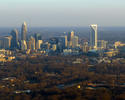In recent history, the United States has arguably never been so divided — but not in the way you might think. Yes, the country has been split by the culture wars, with their polarising focus on race and gender. But behind the scenes, another conflict has been brewing; shaped by the economics of class, it has created two Americas increasingly in conflict. read more »
Small Cities
The Killing of Kern County
Located over the mountains from Los Angeles, Kern County has always been a different kind of place. Settled largely by “Okies and Arkies” from the Depression-era South, the area has a culture more southern than northern, more Ozarks than Sierra. Home to just under 1 million people at the southern end of the state’s Central Valley, Kern is noted for producing the “Bakersfield sound,” epitomized by the late country star Merle Haggard, and is sometimes even referred to as “little Texas.” read more »
- Login to post comments
Suburbs Are Not Less Social Than Cities
Popular culture and academia alike are quick to celebrate the vibrant social life of urban spaces while lamenting the sprawling emptiness and privacy of rural and suburban America. read more »
- Login to post comments
The Next Entrepreneurial Revolution
The coronavirus pandemic has altered the future of American business. The virus-driven disruption has proved more profound than anything imagined by Silicon Valley, costing more jobs than in any year since the Great Depression. read more »
Joe Biden's Imaginary America
After two painful recessions and ever greater national discord, there is considerable support for a new beginning, even if it takes massive federal spending. The question we must ask now is what kind of spending makes sense given the character of the country, its geography, and its economic challenges. America remains a vast and diverse place, and decisions that make sense for one locale do not necessarily make any sense in others. A dispersed country needs dispersed decision-making, not edicts issued from on high by the D.C. nomenklatura. read more »
- Login to post comments
Cricket Leagues in the Global Heartland
The cracking sound of cricket bats is echoing amid the gently rolling hills and plains of Iowa.
With leagues springing up like soybeans, cricket is drawing players and fans in the Heartland, spurred by demographic change and a growing economy. Cricket’s growth in the Heartland reflects immigrants transplanting to American soil a homeland sports tradition – and enriching the culture we share. read more »
- Login to post comments
Census Bureau Releases 2020 City Population Estimates
The US Census Bureau has just released its July 1, 2020 population estimates for the approximately 19,500 incorporated municipalities (principally called cities, towns, villages). This article provides information on the 50 largest municipalities in the nation (Table below). read more »
Combined Statistical Areas Lead Continuing Dispersion: 2010-2020
A commenter asked about population trends in combined statistical areas (CSA) in response to my article “Demographic Implosion in the San Francisco Bay Area?, posted on May 18. This article deals with CSA population trends in the 88 CSAs with more than 500,000 population. read more »
- Login to post comments
Demographic Implosion in the San Francisco Bay Area?
As the San Francisco Bay Area (combined statistical area, or CSA, as defined by the Office of Management and Budget) has sprawled into the San Joaquin Valley, all population growth has been in the three Valley metros for two years (Map above). This article describes population trends over the last 10 years in the CSA, which includes the six tidewater (adjacent to the ocean or the Bay) metropolitan areas, traditionally thought of as the Bay Area, including core San Francisco and San Jose as well as Santa Rosa, Napa, Vallejo and Santa Cruz. read more »
America’s Post-Pandemic Geography
Even as vaccination increases across the United States and an end to the tragedy of the Covid-19 pandemic seems in sight, the economic, fiscal, political, and geographic fallout from the virus cannot be overstated: a massive public health crisis that left more than half a million Americans dead, an economic catastrophe that caused record unemployment and small-business closures, and a seismic political event that surely helped tip the presidential election. The pandemic will pass, and the economy will revive, as it is already doing. read more »
- Login to post comments






















